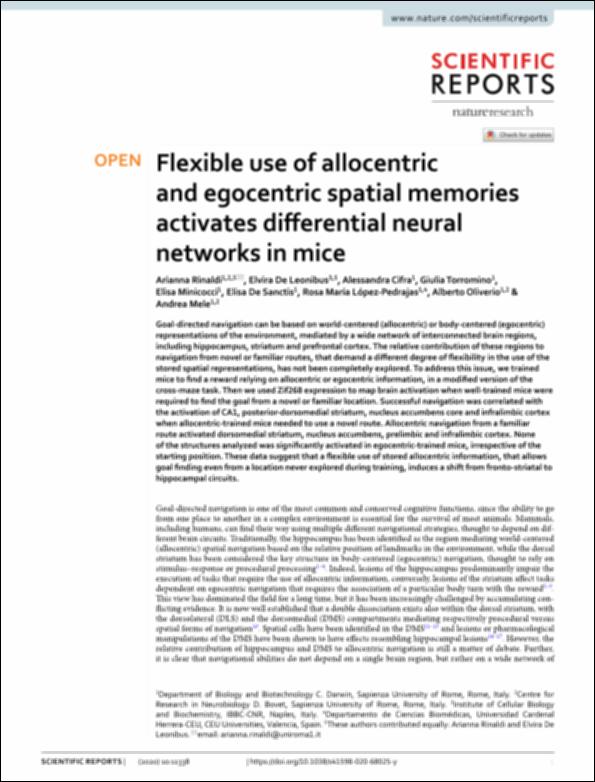Please use this identifier to cite or link to this item:
http://hdl.handle.net/10637/12713Flexible use of allocentric and egocentric spatial memories activates differential neural networks in mices
| Title: | Flexible use of allocentric and egocentric spatial memories activates differential neural networks in mices |
| Authors : | Rinaldi, Arianna De Leonibus, Elvira Cifra, Alessandra Torromino, Giulia Minicocci, Elisa De Sanctis, Elisa López Pedrajas, Rosa María |
| Keywords: | Memory.; Redes neuronales (Neurobiología); Memoria.; Neurobiology.; Neurobiología.; Neural networks (Neurobiology) |
| Publisher: | Nature Research. |
| Citation: | Rinaldi, A., De Leonibus, E., Cifra, A., Torromino, G., Minicocci, E., De Sanctis, E. et al. (2020). Flexible use of allocentric and egocentric spatial memories activates differential neural networks in mice. Scientific Reports, vol. 10, art. 11338 (09 jul.). DOI: https://doi.org/10.1038/s41598-020-68025-y |
| Abstract: | Goal-directed navigation can be based on world-centered (allocentric) or body-centered (egocentric) representations of the environment, mediated by a wide network of interconnected brain regions, including hippocampus, striatum and prefrontal cortex. The relative contribution of these regions to navigation from novel or familiar routes, that demand a different degree of flexibility in the use of the stored spatial representations, has not been completely explored. To address this issue, we trained mice to find a reward relying on allocentric or egocentric information, in a modified version of the cross-maze task. Then we used Zif268 expression to map brain activation when well-trained mice were required to find the goal from a novel or familiar location. Successful navigation was correlated with the activation of CA1, posterior-dorsomedial striatum, nucleus accumbens core and infralimbic cortex when allocentric-trained mice needed to use a novel route. Allocentric navigation from a familiar route activated dorsomedial striatum, nucleus accumbens, prelimbic and infralimbic cortex. None of the structures analyzed was significantly activated in egocentric-trained mice, irrespective of the starting position. These data suggest that a flexible use of stored allocentric information, that allows goal finding even from a location never explored during training, induces a shift from fronto-striatal to hippocampal circuits. |
| Description: | Este artículo se encuentra disponible en la siguiente URL: https://www.nature.com/articles/s41598-020-68025-y.pdf En este artículo también participan: Alberto Oliverio y Andrea Mele. |
| URI: | http://hdl.handle.net/10637/12713 |
| Rights : | http://creativecommons.org/licenses/by/4.0/deed.es |
| ISSN: | 2045-2322 (Electrónico). |
| Issue Date: | 9-Jul-2020 |
| Center : | Universidad Cardenal Herrera-CEU |
| Appears in Collections: | Dpto. Ciencias Biomédicas |
Items in DSpace are protected by copyright, with all rights reserved, unless otherwise indicated.


